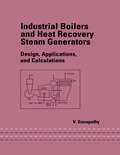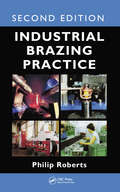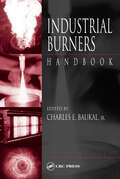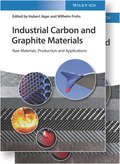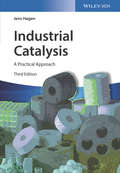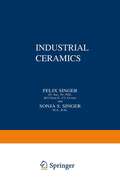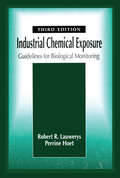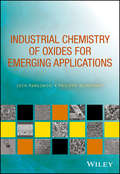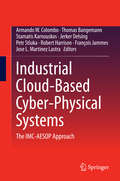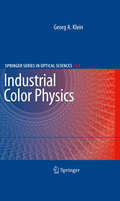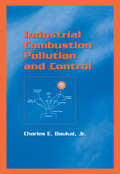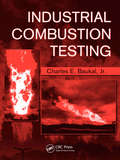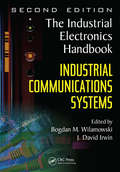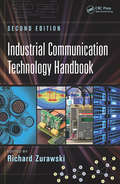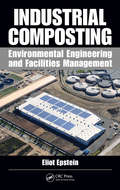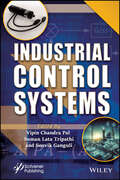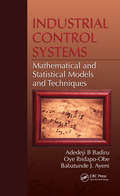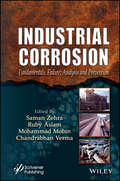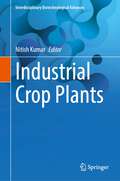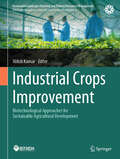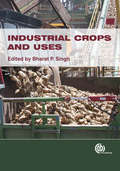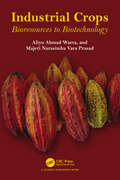- Table View
- List View
Industrial Biotechnology
by Debabrata Das Soumya PanditIndustrial Biotechnology offers a comprehensive overview of biochemical processes, technologies, and practical applications of industrial biotechnology. The work comprises of chapters that discuss medium preparation, inoculum preparation using industrial strain and upstream processing, various fermentation processes, and physico-chemical separation processes for the purification of products and packaging. Analyzes problems within biochemical processes Discusses stoichiometry of bioprocesses Covers upstream and downstream processing Offers a wealth of case studies of different biochemical production processes, including those in development of food products, vaccines and medicines, single cell proteins, amino acids, cheese, biodiesel, biopesticides, and more This book is aimed at advanced students, industrial practitioners, and researchers in biotechnology, food engineering, chemical engineering, and environmental engineering.
Industrial Boilers and Heat Recovery Steam Generators: Design, Applications, and Calculations (Mechanical Engineering)
by V. GanapathyFilled with over 225 boiler/HRSG operation and design problems, this book covers steam generators and related systems used in process plants, refineries, chemical plants, electrical utilities, and other industrial settings. Emphasizing the thermal engineering aspects, the author provides information on the design and performance of steam generators
Industrial Brazing Practice
by Philip RobertsIn the past ten years, brazing technology has undergone sweeping changes. Yet because there are so few practitioners who understand the finer points of the technology, many of the companies that use brazing as their preferred metal-joining procedure are failing to use it to best effect. Fully updated to reflect the latest practices, this second edi
Industrial Burners Handbook (Industrial Combustion)
by Charles E. Baukal JrRapid development in the field precipitated by the increased demand for clean burner systems has made the Industrial Burners Handbook into the fields go-to resource. With this resource, bestselling author, editor, and combustion expert Charles Baukal, Jr. has put together a comprehensive reference dedicated to the design and applications of indust
Industrial Carbon and Graphite Materials: Raw Materials, Production and Applications
by JageerAn excellent overview of industrial carbon and graphite materials, especially their manufacture, use and applications in industry. Following a short introduction, the main part of this reference deals with industrial forms, their raw materials, properties and manifold applications. Featuring chapters on carbon and graphite materials in energy application, and as catalysts. It covers all important classes of carbon and graphite, from polygranular materials to fullerenes, and from activated carbon to carbon blacks and nanoforms of carbon.Indispensable for chemists and engineers working in such fields as steel, aluminum, electrochemistry, nanotechnology, catalyst, carbon fibres and lightweight composites.
Industrial Catalysis
by Jens HagenIn its 3rd edition, this comprehensive book offers all relevant information on catalytic processes in industry, including many recent examples. Perfectly suited for self-study, it is the ideal companion for scientists who want to get into the field or refresh existing knowledge.
Industrial Chemical Exposure: Guidelines for Biological Monitoring, Third Edition
by Robert R. Lauwerys Perrine HoetThe bestselling resource on industrial chemical assessment just got better. A practical guide to biological monitoring for industrial chemical exposure assessment, the THIRD EDITION of INDUSTRIAL CHEMICAL EXPOSURE: GUIDELINES FOR BIOLOGICAL MONITORING has been completely revised to include the latest developments in the field. In addition to an upd
Industrial Chemistry of Oxides for Emerging Applications
by Lech Pawlowski Philippe BlanchartValuable insights into the extraction, production, and properties of a large number of natural and synthetic oxides utilized in applications worldwide from ceramics, electronic components, and coatings This handbook describes each of the major oxides chronologically—starting from the processes of extraction of ores containing oxides, their purification and transformations into pure alloyed powders, and their appropriate characterization up to the processes of formation of 2D films by such methods as PVD, CVD, and coatings by thermal spraying or complicated 3D objects by sintering and rapid prototyping. The selection of oxides has been guided by the current context of industrial applications. An important point that is considered in the book concerns the strategic aspects of oxides. Some oxides (e.g. rare earth ones) become more expensive due to the growing demand for them, others, because of the strategic importance of countries producing raw materials and the countries that are using them. Industrial Chemistry of Oxides for Emerging Applications provides readers with everything they need to know in 7 chapters that cover: technical and economical importance of oxides in present and future; fundamentals of oxides manufacturing; extraction, properties, and applications of Al2O3; extraction, properties, and applications of ZrO2; synthesis, properties, and applications of YBaCu2O7x; extraction, properties, and applications of TiO2; and synthesis, properties, and application of hydroxyapatite. Presents the extraction, production, and properties of a large fraction of oxides applications worldwide, both natural as well as synthetic multi‐oxides Covers a very important segment of many industrial processes, such as refractories and piezoelectric oxides—both applications constituting very large market segments Developed from a lecture course given by the authors for over a decade Industrial Chemistry of Oxides for Emerging Applications is an excellent text for university professors and teachers, and graduate and postgraduate students with a solid background in physics and chemistry.
Industrial Chocolate Manufacture and Use
by Stephen T. BeckettSince the third edition of this standard work in 1999, there has been a significant increase in the amount of chocolate manufactured worldwide. The fourth edition of Industrial Chocolate Manufacture and Use provides up-to-date coverage of all major aspects of chocolate manufacture and use, from the growing of cocoa beans to the packaging and marketing of the end product. Retaining the important and well-received key features of the previous edition, the fourth edition also contains completely new chapters covering chocolate crumb, cold forming technologies, intellectual property, and nutrition. Furthermore, taking account of significant changes and trends within the chocolate industry, much new information is incorporated, particularly within such chapters as those covering the chemistry of flavour development, chocolate flow properties, chocolate packaging, and chocolate marketing. This fully revised and expanded new edition is an essential purchase for all those involved in the manufacture and use of chocolate.
Industrial Cloud-Based Cyber-Physical Systems
by Robert Harrison Stamatis Karnouskos Armando W. Colombo Thomas Bangemann Jerker Delsing Petr Stluka Francois Jammes Jose L. LastraThis book presents cutting-edge emerging technologies and approaches in the areas of service-oriented architectures, intelligent devices and cloud-based cyber-physical systems. It provides a clear view on their applicability to the management and automation of manufacturing and process industries. It offers a holistic view of future industrial cyber-physical systems and their industrial usage and also depicts technologies and architectures as well as a migration approach and engineering tools based on these. By providing a careful balance between the theory and the practical aspects, this book has been authored by several experts from academia and industry, thereby offering a valuable understanding of the vision, the domain, the processes and the results of the research. It has several illustrations and tables to clearly exemplify the concepts and results examined in the text and these are supported by four real-life case-studies. We are witnessing rapid advances in the industrial automation, mainly driven by business needs towards agility and supported by new disruptive advances both on the software and hardware side, as well as the cross-fertilization of concepts and the amalgamation of information and communication technology-driven approaches in traditional industrial automation and control systems. This book is intended for technology managers, application designers, solution developers, engineers working in industry, as well as researchers, undergraduate and graduate students of industrial automation, industrial informatics and production engineering.
Industrial Color Physics (Springer Series in Optical Sciences #154)
by Georg A. KleinColors arise only in the brain, normally originating from electromagnetic waves from the outside world. This book is based on courses given by the author in the Department of Colors, Paints and Plastics at the University of Applied Sciences in Stuttgart and continued at the University of Applied Sciences in Esslingen, Germany. The development of color physics in industry began in the middle of the 19th century with the large-scale manufacturing of natural colors. Since that time, a great variety of new, especially synthetic, colorants have been produced in order to meet increasing demands for non-self-luminous colors with regard to color applications. The rapid progress in color physics and accompanying applications over the last three decades are the reasons for this work. Here, the fundamentals of color physics are outlined and the most important recent developments and applications in the color industry are discussed. 1 In comparison to the ?rst German edition, all chapters of the book have been revised and expanded with regard to effect pigments. After the introd- tory chapter, the optical fundamentals of absorbing and effect colorants are discussed. The exceptional spectral and colorimetric properties of effect p- ments are detailed in combination with further characterizing parameters. Color spaces are presented as well as the ef?ciency of recent color difference f- mulas. In addition to the normal spectral measuring methods for absorbing colorants, modi?ed procedures for effect colorations are outlined.
Industrial Combustion Pollution and Control (Environmental Science And Pollution Ser. #Vol. 27)
by Jr. Charles E. BaukalThis reference overflows with an abundance of experimental techniques, simulation strategies, and practical applications useful in the control of pollutants generated by combustion processes in the metals, minerals, chemical, petrochemical, waste, incineration, paper, glass, and foods industries. The book assists engineers as they attempt to meet e
Industrial Combustion Testing
by Charles E. BaukalThe first resource of its kind, this work compiles all of the latest testing techniques to serve as a comprehensive resource for those conducting tests in the field of industrial combustion. It serves the needs of practicing engineers, technicians, and researchers conducting experiments with industrial scale combustion equipment, and it will save researchers endless hours searching the literature. It includes numerous pictures, figures, graphs, and tables, as well as examples on how to apply the information. It includes valuable information on advanced diagnostics, burner and flare testing, and testing in combustors, including a variety of kilns, furnaces, and boilers.
Industrial Communication Systems
by Bogdan M. Wilamowski and J. david IrwinThe Industrial Electronics Handbook, Second Edition, Industrial Communications Systems combines traditional and newer, more specialized knowledge that helps industrial electronics engineers develop practical solutions for the design and implementation of high-power applications. Embracing the broad technological scope of the field, this collection explores fundamental areas, including analog and digital circuits, electronics, electromagnetic machines, signal processing, and industrial control and communications systems. It also facilitates the use of intelligent systems—such as neural networks, fuzzy systems, and evolutionary methods—in terms of a hierarchical structure that makes factory control and supervision more efficient by addressing the needs of all production components. Enhancing its value, this fully updated collection presents research and global trends as published in the IEEE Transactions on Industrial Electronics Journal, one of the largest and most respected publications in the field. Modern communication systems in factories use many different—and increasingly sophisticated—systems to send and receive information. Industrial Communication Systems spans the full gamut of concepts that engineers require to maintain a well-designed, reliable communications system that can ensure successful operation of any production process. Delving into the subject, this volume covers: Technical principles Application-specific areas Technologies Internet programming Outlook, including trends and expected challenges Other volumes in the set: Fundamentals of Industrial Electronics Power Electronics and Motor Drives Control and Mechatronics Intelligent Systems
Industrial Communication Technology Handbook (Industrial Information Technology #8)
by Richard ZurawskiFeaturing contributions from major technology vendors, industry consortia, and government and private research establishments, the Industrial Communication Technology Handbook, Second Edition provides comprehensive and authoritative coverage of wire- and wireless-based specialized communication networks used in plant and factory automation, automotive applications, avionics, building automation, energy and power systems, train applications, and more. New to the Second Edition: 46 brand-new chapters and 21 substantially revised chapters Inclusion of the latest, most significant developments in specialized communication technologies and systems Addition of new application domains for specialized networks The Industrial Communication Technology Handbook, Second Edition supplies readers with a thorough understanding of the application-specific requirements for communication services and their supporting technologies. It is useful to a broad spectrum of professionals involved in the conception, design, development, standardization, and use of specialized communication networks as well as academic institutions engaged in engineering education and vocational training.
Industrial Composting: Environmental Engineering and Facilities Management
by Eliot EpsteinThe ultimate in recycling, composting has been in use in some form since ancient times. A well-managed composting facility should exist as a good neighbor contributing to ecology. However, since local populations often perceive risks if a composting facility is built nearby, composting facilities must be designed and operated with minimal odor, dus
Industrial Control Systems
by Suman Lata Tripathi Souvik Ganguli Vipin Chandra PalINDUSTRIAL CONTROL SYSTEMS This volume serves as a comprehensive guide in the journey of industrial control systems with a multidisciplinary approach to the key engineering problems in the 21st century. The journey of the control system may be viewed from the control of steam engines to spacecraft, aeroplane missile control systems to networked control systems and cybersecurity controls. In terms of industrial control and application, the journey starts from the design of P-I-D controllers to fuzzy controllers, neuro-fuzzy controllers, backstepping controllers, sliding mode controllers, and event-triggered controls for networked control systems. Recently, control theory has spread its golden feathers in different fields of engineering by use of the splendid tool of the control system. In this era, the boom of the Internet of Things is at its maximum pace. Different biomedical applications also come under this umbrella and provide the easiest way to continuous monitoring. One of the prominent research areas of green energy and sustainable development in which control plays a vital role is load frequency controllers, control of solar thermal plants, an event-driven building energy management system, speed-sensorless voltage and frequency control in autonomous DFIG-based wind energy, Hazardous Energy Control Programs, and many more. This exciting new volume: Offers a complete journey through industrial control systems Is written for multidisciplinary students and veteran engineers alike Benefits researchers from diverse disciplines with real-world applications
Industrial Control Systems: Mathematical and Statistical Models and Techniques (Systems Innovation Book Series)
by Adedeji B. Badiru Oye Ibidapo-Obe Babatunde J. AyeniIssues such as logistics, the coordination of different teams, and automatic control of machinery become more difficult when dealing with large, complex projects. Yet all these activities have common elements and can be represented by mathematics. Linking theory to practice, Industrial Control Systems: Mathematical and Statistical Models and Techni
Industrial Corrosion: Fundamentals, Failure, Analysis and Prevention
by Mohammad Mobin Chandrabhan Verma Ruby Aslam Saman ZehraThe book equips professionals with essential insights into corrosion science, practical techniques for diagnosis and prevention, and access to the latest advancements in the field, making it an invaluable resource for enhancing industry practices and safeguarding assets. Industrial Corrosion: Fundamentals, Failure, Analysis and Prevention offers an in-depth look at the science behind corrosion and its impact on industries worldwide. Covering both theoretical and practical aspects, this volume provides a clear understanding of corrosion mechanisms, materials degradation, and the reasons behind common industrial failures. It explores advanced techniques for diagnosing corrosion issues and presents effective solutions to mitigate and prevent them. The book not only delves into traditional corrosion control methods but also highlights the latest advancements in corrosion inhibitors and smart coatings, showcasing cutting-edge technologies that can revolutionize industry practices. With practical case studies, real-world examples, and expert insights, this comprehensive guide serves as a crucial resource for engineers, researchers, and professionals seeking to enhance their knowledge and apply corrosion prevention techniques in their work. Provides a detailed exploration of corrosion fundamentals, failure mechanisms, and prevention strategies, perfect for professionals and students alike Includes practical case studies and examples to help readers apply corrosion prevention methods in various industries Highlights the latest innovations in corrosion inhibitors and smart coatings for enhanced industrial protection Audience Engineers, materials scientists, chemists, academics, researchers, and professionals in corrosion prevention, oil and gas, manufacturing, transportation, and infrastructure, where corrosion control is critical.
Industrial Crop Plants (Interdisciplinary Biotechnological Advances)
by Nitish KumarIndustrial crops offer farmers new market opportunities to increase their revenue by producing high-value products, focusing on fiber, forest, and energy crops, industrial oilseeds, rubber and resins, pharmaceuticals, and more. Technological innovations in agriculture have facilitated higher yields, but conserving crop genetic resources and diversity remains crucial for sustainable agricultural production. This poses a challenge that can be addressed through modern tools of biotechnology and genomics, utilizing the wealth of sequenced plant genomes. This book addresses the need for knowledge in managing the risks and conservation of genetic diversity associated with advanced technology. It provides comprehensive coverage of plant genomics and biotechnology, catering to post-graduate students, researchers, employees of seed and biotechnology companies, as well as instructors in plant genetics, breeding, and biotechnology fields.
Industrial Crops Improvement: Biotechnological Approaches for Sustainable Agricultural Development (Sustainable Landscape Planning and Natural Resources Management)
by Nitish KumarThis book explores the different conventional and biotechnological techniques for enhancing the productivity of industrial crops. The growth of the industrial crop sector has become a widespread global phenomenon that helps rural livelihoods and propels economic development. Contrary to staple crops, industrial crops are cultivated with the intention of being sold for a high profit. Industrial crops are a crucial component of plans to increase food security because they offer the required stability during periods of economic or climatic crises. In order to maintain their livelihood and food security, many farm households balance the advantages and disadvantages of producing food crops and industrial crops. Avoiding land-use rivalry with crops grown for food and feed production is crucial when considering growing industrial crops on agricultural soils. The past several years have seen a rise in the awareness of scholars and decision-makers regarding the immediate and long-term effects of climatic variables on economic, food security, social, and political results. In order to sustain food production with more climate-resilient crops for future generations, genetic variety, both natural and artificial, is crucial. Therefore, addressing the problem of finding a compromise between increasing crop production under a specific set of conditions and reducing the chance of crop failure when conditions change is important and difficult. An assortment of meteorological conditions is used to grow industrial crops. Many are subsistence farmers who run extremely tiny farms with very little agricultural input to produce products that can be sold. It is a significant problem to preserve the variety of these crops and handle all crop culture-related difficulties. By offering the knowledge required to minimize the dangers of industrial crop breeding through managing genetic diversity, the author believe that this book will primarily address a need that has not yet been met in this and other grower groups.
Industrial Crops and Uses
by Bharat P. SinghThe book discusses the identification of plant species with desired traits, their cultivation to obtain the needed raw materials, methods utilized in producing different finished products, current and future research in crop production and processing, and the present status and future prospects of the industry.
Industrial Crops: Bioresources to Biotechnology
by Majeti Narasimha Prasad Aliyu Ahmad WarraThis book captures how industrial crops can be used in conventional agriculture and greener biopharming for pharmaceutical industries. Pharmaceuticals and industrial compounds are studied from the perspective of their co-existence with plant resources and byproducts. Such plant-based industrial products rely on scientific and technological breakthroughs and provide new opportunities for the agricultural sector, at the same time mitigate the risks associated with climate change. The management of the externalities and of the possible unintended economic effects that arise in this context is critical and poses difficult questions for regulators. The book also provides a review of the emerging agro-industrial biomass technology involved in conversion of most of the solid transgenic industrial crops by products such as plant oil lignocellulosic materials into liquid biobased energy-fuels. The book covers how innovative biotechnology can expand the markets for agricultural producers worldwide, reduce environmental degradation, and provide alternatives to fossil carbon-derived products and energy. Aspects of entrepreneurial biotechnology and bioprospecting are also covered.
Industrial Crystallization
by Lewis, Alison Emslie and Seckler, Marcelo Martins and Kramer, Herman and van Rosmalen, Gerda Alison Emslie Lewis Marcelo Martins Seckler Herman Kramer Gerda Van RosmalenCrystallization is an important technique for separation and purification of substances as well as for product design in chemical, pharmaceutical and biotechnological process industries. This ready reference and handbook draws on research work and industrial practice of a large group of experts in the various areas of industrial crystallization processes, capturing the essence of current trends, the markets, design tools and technologies in this key field. Along the way, it outlines trouble free production, provides laboratory controls, analyses case studies and discusses new challenges. First the instrumentation and techniques used to measure the crystal size distribution, the nucleation and solubility points, and the chemical composition of the solid and liquid phase are outlined. Then the main techniques adopted to control industrial crystallizers, starting from fundamental approaches to the most advanced ones, including the multivariable predictive control are described. An overview of the main crystallizer types is given with details of the main control schemes adopted in industry as well as the more suitable sensors and actuators.

